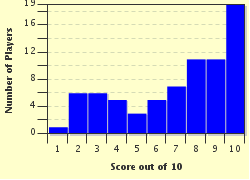Quiz Answer Key and Fun Facts
1. There is a plaque in Ballarat that signals the first defeat of an English XI in a cricket match on Victorian soil. This occurred in 1854, but what was unusual about the contest?
2. The first cricket Test match was played by Australia against England at Melbourne in March 1877. Was this labelled at the time as the first official "Ashes" Test match?
3. "The Australians came down like a wolf on the fold,
the Marylebone stars for a trifle were bowled.
Our Grace before dinner, was very soon done,
and Grace after dinner, didn't get a run".
This parody appeared in the "London Punch" in 1878 as a tribute to Australian tenacity and the poor showing by England. In a Test match three years later England were to snatch defeat from the jaws of victory. Which event, that followed, supposedly signalled the "death" of English cricket?
4. Following the announcement of the "death" of English cricket in 1882, when England snatched defeat froim the jaws of victory, two women (wives of MCC Board members), burnt the official scoresheet and presented the remains to Dr WG Grace, thereby creating the Ashes?
5. Where do the Ashes, the trophy for cricket contests between Australia and England, reside?
6. Gamesmanship, which incorporates sledging, has been a noticeable part of the cricketing clashes between Australia and England. Which Australian captain, known as the "Big Ship", caused a stir by picking up a newspaper whilst on the field and proceeded to read it?
7. "There are two teams out there and one of them is trying to play cricket"
For the 1932 tour of Australia England's captain, Douglas Jardine, employed which insidious but aptly titled tactic to bring down Australia's powerful batting line-up?
8. Even when the Ashes were not on the line in cricket contests between Australia and England, the intensity did not lessen. Which batsman defied doctor's orders to bat with a broken jaw during Australia's second innings of the 1977 Centenary Test match?
9. For the 1989 cricket tour of England, which Australian captain instructed his players to "get mean" and banned the wives and girlfriends from joining the team until the Ashes had been secured?
10. Such was the euphoria of England's 2005 Ashes victory that every English cricketer who had participated in the series was awarded an MBE (Member of the British Empire) medallion by the Queen.
Source: Author
VegemiteKid
This quiz was reviewed by FunTrivia editor
gtho4 before going online.
Any errors found in FunTrivia content are routinely corrected through our feedback system.

